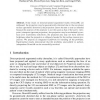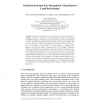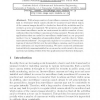ACCV
2006
Springer
15 years 7 months ago
2006
Springer
Although most works in computer vision use perspective or other central cameras, the interest in non-central camera models has increased lately, especially with respect to omnidire...
ACCV
2006
Springer
15 years 7 months ago
2006
Springer
The need for empirical evaluation metrics and algorithms is well acknowledged in the field of computer vision. The process leads to precise insights to understanding current techn...
ACCV
2006
Springer
15 years 7 months ago
2006
Springer
Abstract. We present an alignment framework for object detection using a hierarchy of 3D polygonal models. One difficulty with alignment methods is that the high-dimensional transf...
114
click to vote
ACCV
2006
Springer
15 years 7 months ago
2006
Springer
We view the task of change detection as a problem of object recognition from learning. The object is defined in a 3D space where the time is the 3rd dimension. We propose two com...
131
click to vote
ACCV
2006
Springer
15 years 7 months ago
2006
Springer
We present a novel method to transfer speech animation recorded in low resolution videos onto realistic 3D facial models. Unsupervised learning is utilized on a speech video corpus...
ACCV
2006
Springer
15 years 7 months ago
2006
Springer
Some issues on direct-projected augmented reality (DirectAR) are addressed: the projection may be geometrically distorted due to the non-planar surface (geometric distortion); the ...
127
click to vote
ACCV
2006
Springer
15 years 7 months ago
2006
Springer
Abstract. This paper presents a motion capture system using two cameras that is capable of estimating a constrained set of human postures in real time. We first obtain a 3D shape ...
106
click to vote
ACCV
2006
Springer
15 years 7 months ago
2006
Springer
In this paper, we propose a novel occlusion invariant face recognition algorithm based on Selective Local Nonnegative Matrix Factorization (S-LNMF) technique. The proposed algorith...
117
click to vote
ACCV
2006
Springer
15 years 7 months ago
2006
Springer
Performing segmentation of narrow, elongated structures with low contrast boundaries is a challenging problem. Boundaries of these structures are difficult to be located when noise...
ACCV
2006
Springer
15 years 7 months ago
2006
Springer
With a large number of surveillance cameras, it is not an easy task to determine which camera should be monitored and which region of the camera images should be checked so that al...



